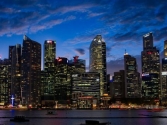Thought Leadership Centre
Most Read
1. Singapore urged to increase renewable grid interconnection investment 2. MTI and EMA seek feedback on energy legislation changes 3. Meralco plans micro-nuclear power plants for remote areas by 2028 4. Pressures mount for less desirable energy insurance placements in the region 5. India's renewable energy tender issuances reach record 69 GWResource Center
Awards
Oct
22
Oct
22
Oct
22
Event News
Event News
Thailand at the forefront of ASEAN's energy transition: A look ahead to Future Energy Asia
Co-Written / Partner
Co-hosted by industry leaders and supported by government officials, the Future Energy Asia Exhibition and Summit aims to accelerate the region's journey towards net-zero emissions.
Co-Written / Partner
Thailand at the forefront of ASEAN's energy transition: A look ahead to Future Energy Asia
Co-hosted by industry leaders and supported by government officials, the Future Energy Asia Exhibition and Summit aims to accelerate the region's journey towards net-zero emissions.
Videos
Partner Sites
Join the community
Thought Leadership Centre
Most Read
1. Singapore urged to increase renewable grid interconnection investment 2. MTI and EMA seek feedback on energy legislation changes 3. Meralco plans micro-nuclear power plants for remote areas by 2028 4. Pressures mount for less desirable energy insurance placements in the region 5. India's renewable energy tender issuances reach record 69 GWAwards
Oct
22
Oct
22
Oct
22

 Advertise
Advertise




















Commentary
Enabling cleaner power generation in Asia through digital prototyping
Enabling cleaner power generation in Asia through digital prototyping
China power market growth - green energy and opportunities
What's for Asia a decade after California and Enron
Is Asia ready for new nuclear power plants?
China's nuclear power potential
Is there enough land supply for power plant projects?
India on the move towards solar energy
Will Smart Grid Utility space continue to expand?
Asia coal power development now and beyond
What you need to know about geothermal energy
Southeast Asia embraces solar power
Can renewable energy growth continue without storage?
Renewable energy and the challenges for Asian power markets
How to deliver stakeholder confidence
The over-bearing dependence on (inadequate) regulation
Here’s why most companies are reducing their energy cost
Direct-drive wind turbines: Can the Chinese keep their lead?